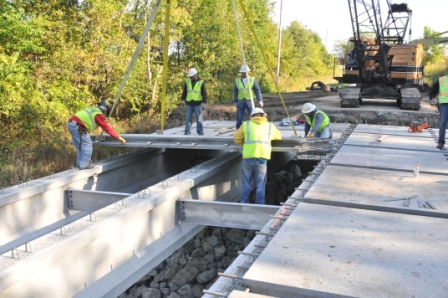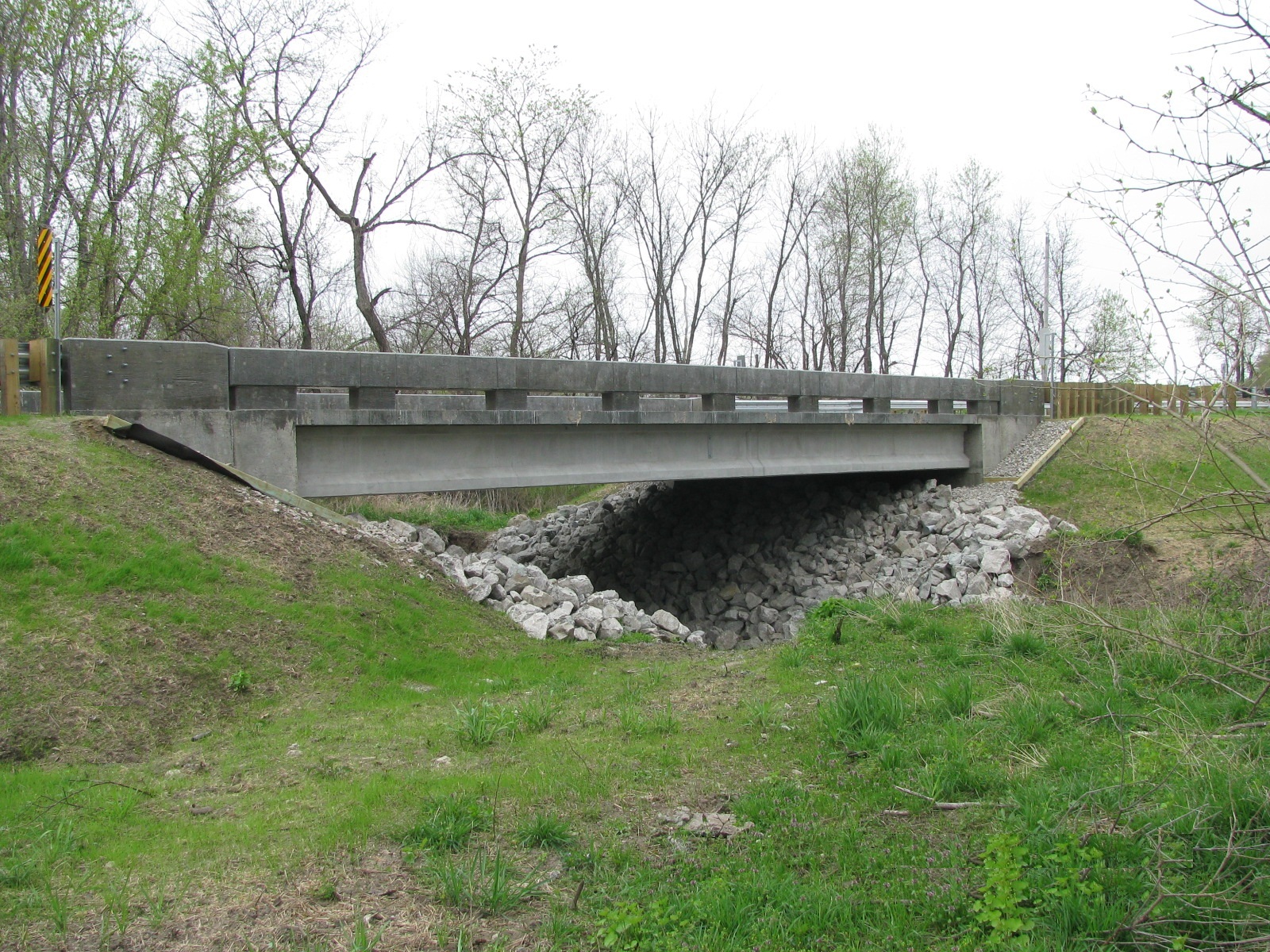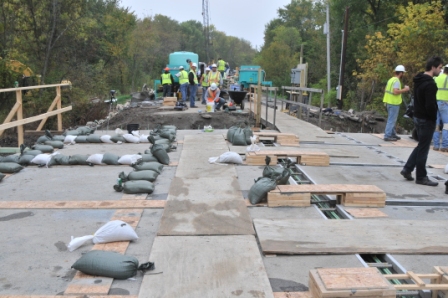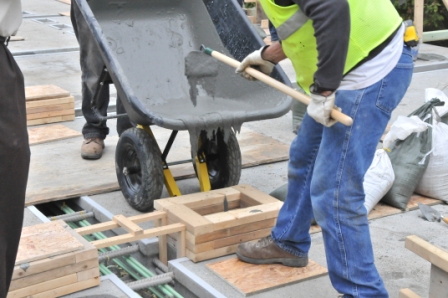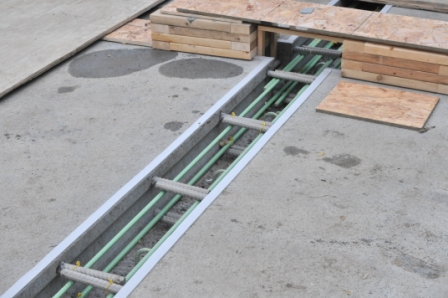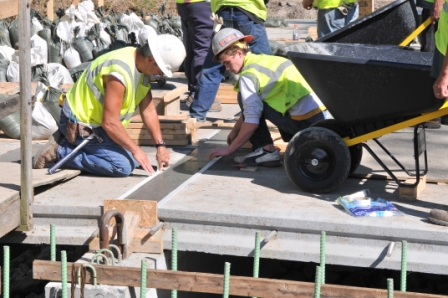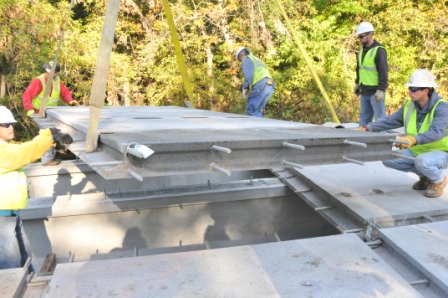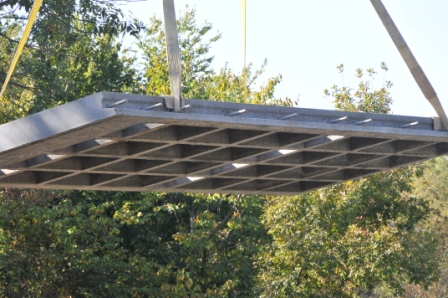State: IA
County:
Owner: Wapello County
Location: Urban
Spans: One-span
Beam material: Concrete
Max Span Length (ft.): 60
Total Bridge Length (ft.): 60
Construction Equipment Category: Conventional
ABC Construction Equipment: Conventional
State ID Number: 39-331250
NBI Number: 331251
Coordinates
Latitude: 41.0708237 | Longitude: -92.3632355
Bridge Description
Project Summary:Project Location:
on Dahlonega Road (Co. Hwy. H25) crossing Little Cedar Creek in Wapello County southeast of Des Moines
Impact Category:
Tier 5 (within 3 months)
Mobility Impact Time:
ABC: 40 working days; Conventional: 50 working days
Primary Drivers:
reduced traffic impacts, reduced onsite construction time, improved material quality and product durability, improved site constructability
Dimensions:
60-ft long and 33.17-ft wide single-span prestressed I-beam bridge
Average Daily Traffic (at time of construction):
310
Traffic Management (if constructed conventionally):
Traffic management alternative, if constructed conventionally: extended use of 4-mile detour
Existing Bridge Description:
The existing two-lane single-span prestressed concrete I-beam bridge was 57-ft-long and 26-ft-wide, with timber abutments. Built in 1960, it was deteriorated and required replacement.
Replacement or New Bridge:
The replacement bridge has two 12-ft-wide traffic lanes and two 3.25-ft-wide shoulders. The superstructure cross-section consists of five 3.25-ft-deep modified standard Iowa Type B60 prestressed I-beams at 7.33-ft spacing and an 8-inch-thick composite precast waffle deck with 1.92-ft overhangs. The waffle deck cross-section consists of two side-by-side panels that are connected at the centerline of the bridge. The design of the 8-ft-long, 16.21-ft-wide panels was based on the AASHTO LRFD Bridge Design Specifications modified empirical method that was validated through laboratory tests. Steel reinforcement in the panels is No. 6 bars. This project is the first in the world to combine precast ultra-high-performance concrete (UHPC) waffle deck panels connected by UHPC field-cast joints. This project used a patented UHPC mix called Ductal®.
Construction Method:
The 14 waffle deck panels were fabricated in the summer and fall of 2010. The measured compressive strength of the UHPC in the panels was 33,700 psi. Construction at the bridge site was delayed until spring 2011 due to flooding in Wapello County during summer 2010.The waffle deck panels were purchased and shipped to the job site under a separate contract between Wapello County and the panel supplier. At the job site each panel was jointly inspected by the county engineer, the panel supplier, and the bridge contractor for structural integrity and potential damage due to shipping and handling, with damage repaired by the panel supplier.The contract plans required the contractor to hold an onsite meeting prior to the initial field placement of the UHPC in the waffle deck panels, attended by the UHPC supplier, the county engineer, and the contractor. The purpose of the meeting was to outline procedures for mixing, transporting, finishing, and curing the UHPC material. The contract also required that a UHPC supplier representative be onsite during the placement of the UHPC.The contractor closed the bridge. The bridge was then demolished conventionally, steel H-piles were driven, and the cast-in-place abutments were constructed. The beams were erected, followed by erection of the waffle deck panels. Field-cast UHPC was placed in the connections between adjacent waffle panels and between the waffle panels and beams. The sequence of UHPC placement was first to fill the twelve 8-inch-wide transverse deck joint locations, then the 112 6-inch by 12-inch blockouts over the beams, and finally the 9-inch-wide centerline longitudinal joint. The surface of the UHPC field joints were filled flush with the precast panels and cured a minimum of four days. The 3.83-ft-wide closure joints at the abutments and the bridge railing were cast with conventional concrete. No overlay was applied.Field testing and evaluation are being conducted on the bridge to provide additional information about the waffle deck performance.No incentives or disincentives were included in the contract.Construction took approximately 40 working days. This was the contractor’s first project using UHPC waffle deck panels and UHPC connections. Experienced gained with this project could lower construction time to 35 working days for a similar project in the future.
Stakeholder Feedback:
The waffle deck is lighter in weight than a concrete deck, can be installed quickly, and is anticipated to be more durable than conventional decks. Construction techniques were not complicated, showing that work can be done by local contractors. Different procedures used during construction with readily available materials will reduce construction time of future projects.
High Performance Material:
UHPC waffle deck and joints
Project Planning
Decision Making Tools:Site Procurement:
Project Delivery: Design-bid-build
Contracting: Full lane closure
Geotechnical Solutions
Foundations & Walls:Rapid Embankment: Fully-contained flooded backfill
Structural Solutions
Prefabricated Bridge Elements: UHPC waffle deckPrefabricated Bridge Systems:
Miscellaneous Prefabricated: CIP reinforced concrete closure joints; Grouted blockout w/shear connectors; UHPC closure joints
Costs & Funding
Costs:The engineer’s estimate for the project was $300,000. The low bid was $372,000 (24% higher than engineer’s estimate). There was one bidder. The cost per square foot of bridge was $179 compared to $85 for conventional construction in this region in 2011.The Highways for LIFE (HfL) Program funded the waffle deck panels for Wapello County. HfL provided a $99,125 grant to the precaster to invest in waffle deck fabrication at their plant in Omaha, produce and test panels (tested at ISU), and supply the panels to Wapello County; included were all materials, labor, and transportation but not the forms, other plant modifications, or the Ductal license fees. The Iowa Highway Research Board provided additional money for testing and field monitoring of the completed bridge. Wapello County provided all other funding for the project.
Funding Source:
Other
Incentive Program:
HfL (Highways for Life): $99,125
Additional Information
Downloadable Resources
Contract Plans:Specifications:
Bid Tabs:
Construction Schedule:
Other Related Information:
April-2011-Research-News
Summary Sheets:
April-2011-Research-News
120416-ABC_New2_IA_2011_Little-Cedar-Creek_updated
Other Related URLs:
Go to:
http://www.iowadot.gov/bridge/ibrcibrd_research.htm
Go to:
http://www.iowadot.gov/bridge/v8ebrgstd.htm
Wapello County; Iowa Department of Transportation
Contacts
Brian P. Moore, P.E.
Wapello County Engineer
Wapello County
bmoore@wapellocounty.org
641-684-5425




